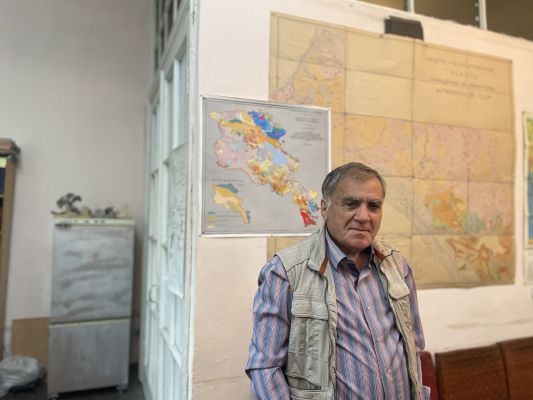Scientist Araik Grigoryan on the Erasmus programme and opportunities for the development of geological sciences in Armenia

Araik Grigoryan, the head of the Laboratory of Paleontology and Stratigraphy of the Institute of Geological Sciences of the National Academy of Sciences of the Republic of Armenia, a PhD. lecturer, explains in detail how the Erasmus programme has changed his own ideas, those of his students, and their research work, while creating opportunities for collaboration.
Mr. Grigoryan, what kind of research is currently being conducted at the Laboratory of Paleontology and Stratigraphy of the Institute of Geological Sciences?
In the laboratory, we conduct studies of organic, marine, and terrestrial remains from various periods, which allow us to understand and clarify the evolution, distribution, and emergence of new species in the organic world. Moreover, as we are in the field of geology, we not only address evolutionary problems but also determine their heights by determining the ages of sedimentary layers of different heights.
Paleontology is a rather broad field that provides an opportunity to explore a variety of geological issues. This laboratory has always existed but has occasionally merged with other laboratories or departments. I saw great prospects for the development of geology in Armenia, particularly in the field of archeology and stratigraphy, and sought to elevate it to a new level. And I believe I have succeeded to some extent, as our archaeological achievements are globally important scientific advancements, not merely local ones.
How did international cooperation begin, particularly with the University of Lille in France?
We have been collaborating for about 10 years. Our laboratory was reorganised in 2014. We created a major programme for paleontological and stratigraphic studies covering different periods. And thanks to that, we had young people who studied, defended their theses, and graduated from the University of Lille.
We achieved considerable success in these areas. We have wonderful geological potential in Armenia, truly textbook-worthy. Many geologists who have visited Armenia emphasise this fact. Our disadvantage is the lack of cutting-edge equipment, so we conduct much of our laboratory research at the University of Lille. For example, we utilise electron microscopy, perform isotopic determinations of different heights, etc.
In view of the interaction you mentioned, can cooperation within the framework of Erasmus be considered effective?
Geologists always gain experience and make progress through collaboration. In the geological field, there have always been various scientific conferences where specialists from different countries could cooperate, exchange experience, and train young people, This has been the case in the past, and now wider doors have opened before us. After the collapse of the Soviet Union, our window of opportunity finally emerged. Once, when I was a graduate student at Moscow University, I received an offer from Austria, but it was made clear to me that I should not even dream about it. Today, we have a ‘window’ to Europe, and it is important that we seize the opportunity to develop Archaeology and stratigraphy in Armenia. We are attracting various students and young people to engage in this field in Armenia. At the moment, eight young people, including undergraduate, master’s, and PhD students from both YSU and the Academy, are actively involved in our laboratory work.
One of them, Vahram Serobyan, being a graduate student of the Academy and Lille University at the same time, successfully defended his thesis before an international jury in September of last year, making a new contribution to international science and literature. Another one of our graduate students, Khachatryan Sirush, left for France in September for threeyears. As a graduate student at the University of Lille, she will be engaged in research on plant remains. Her work is completely novel.
Has the possibility of international cooperation increased the interest in science among young people?
One of my former students once said, ‘Mr Grigoryan, if I knew it was so interesting, I would have pursued it’. The organisation of both masters’ training and specialisation is excellent here. One student is assigned to each laboratory.
When students are exposed to a research and scientific environment outside of their studies, they become better-oriented and engaged. Three students from last year have successfully completed their master’s degrees and are now working in different laboratories within the institute. This is a big achievement. Cooperation with foreign universities is very important. When young individuals are able to prove themselves in the field of science, they become acquainted with articles by foreign specialists and gain opportunities for new cooperation, including financial ones.